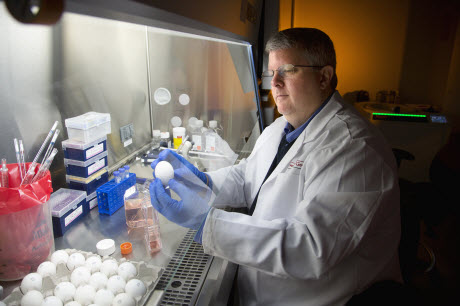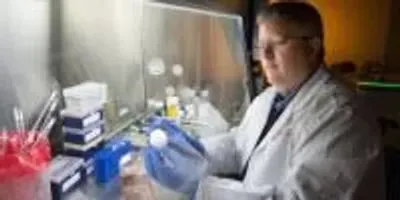 Ted Ross is director of UGA's Center for Vaccines and Immunology. He is a professor and Georgia Research Alliance Eminent Scholar in Infectious Diseases in the College of Veterinary Medicine.Photo Credit: Billy HowardAthens, Ga. – Researchers at the University of Georgia and Sanofi Pasteur, the vaccines division of Sanofi, recently announced the development of a vaccine that protects against multiple strains of both seasonal and pandemic H1N1 influenza in mouse models. They published their findings recently in the Journal of Virology.
Ted Ross is director of UGA's Center for Vaccines and Immunology. He is a professor and Georgia Research Alliance Eminent Scholar in Infectious Diseases in the College of Veterinary Medicine.Photo Credit: Billy HowardAthens, Ga. – Researchers at the University of Georgia and Sanofi Pasteur, the vaccines division of Sanofi, recently announced the development of a vaccine that protects against multiple strains of both seasonal and pandemic H1N1 influenza in mouse models. They published their findings recently in the Journal of Virology.
Researchers from UGA and Sanofi Pasteur, which has a research and development collaboration agreement with UGA, will present their data today March 30, at the World Vaccine Congress US 2016 in Washington, D.C.
"One of the problems with current influenza vaccines is that we have to make predictions about which virus strains will be most prevalent every year and build our vaccines around those predictions," said Ted Ross, director of UGA's Center for Vaccines and Immunology and Georgia Research Alliance Eminent Scholar in Infectious Diseases in the College of Veterinary Medicine. "What we have developed is a vaccine that protects against multiple different strains of H1N1 virus at once, so we might be able to one day replace the current standard of care with this more broadly cross-protective vaccine."
Related Article: Flu Study, On Hold, Yields New Vaccine Technology
The H1N1 influenza virus caused a worldwide pandemic in 2009. When it was first detected, it was called swine flu because the virus was similar to those found in pigs, but the virus now circulates as a seasonal form of influenza.
Using a technique called Computationally Optimized Broadly Reactive Antigen, or COBRA, UGA researchers Donald Carter, Christopher Darby and Bradford Lefoley, along with Ross, created nine prototype synthetic compound vaccines constructed using genetic sequences from multiple influenza virus strains.
The COBRA vaccines were designed to recognize H1N1 viruses isolated within the last 100 years, but many of the experimental vaccines produced immunity against influenza strains not included in the design. This means that scientists may be able to produce a vaccine that not only protects against recognized seasonal and pandemic influenza strains, but also strains that have yet to be discovered.
Because this vaccine is generated from the genetic sequences of multiple flu viruses, it may protect against many strains over several years, Ross said. That would also allow for year-round manufacturing of the vaccine, since scientists would not have to halt production every year to identify the most prevalent strains.
This research is part of a broader effort to create a universal influenza vaccine, which would protect against all strains of the virus.
"We still have some work to do before we get a truly universal flu vaccine," Ross said. "But the COBRA vaccine we've developed for H1N1 virus subtypes is a major step in the right direction."











